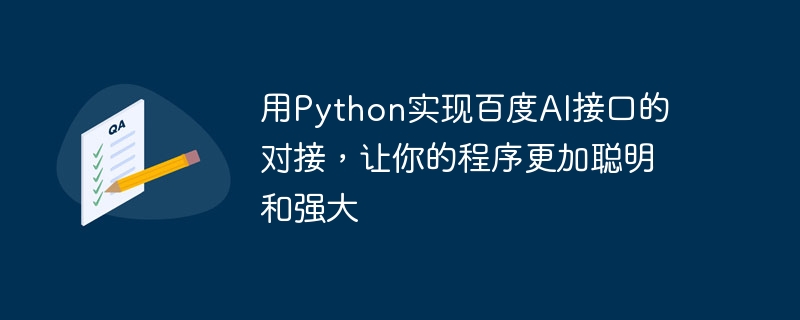用Python實現百度AI介面的對接,讓你的程式更聰明、更強大
- WBOYWBOYWBOYWBOYWBOYWBOYWBOYWBOYWBOYWBOYWBOYWBOYWB原創
- 2023-08-13 17:40:451791瀏覽

用Python實現百度AI介面的對接,讓你的程式更聰明、更強大
隨著人工智慧的快速發展,越來越多的開發者開始將人工智慧技術應用到自己的程式中。而百度AI介面作為國內領先的人工智慧服務供應商,為開發者提供了一系列強大的AI能力,如語音辨識、影像辨識、自然語言處理等。
本文將以Python為例,介紹如何使用百度AI介面來實現程式的智慧化處理。具體而言,我們將實現以下兩個功能:文字辨識和語音合成。
文字辨識(OCR)
文字辨識(OCR)是一種將圖片中的文字擷取出來進行辨識的技術。透過百度AI接口,我們可以輕鬆實現文字辨識的功能。首先,我們需要在百度AI控制台上建立一個應用,並取得對應的API Key和Secret Key。
接下來,我們使用Python的requests函式庫發送POST請求來呼叫百度AI介面。以下是一個簡單的程式碼範例:
import requests
import base64
# 设置百度AI接口的API Key和Secret Key
API_KEY = 'Your API Key'
SECRET_KEY = 'Your Secret Key'
# 图片转base64编码
def image_to_base64(image_path):
with open(image_path, 'rb') as f:
return base64.b64encode(f.read()).decode('utf-8')
# 调用百度AI接口实现文字识别
def ocr(image_path):
request_url = "https://aip.baidubce.com/rest/2.0/ocr/v1/general_basic"
headers = {'Content-Type': 'application/x-www-form-urlencoded'}
base64_data = image_to_base64(image_path)
params = {"image": base64_data}
access_token = get_access_token()
request_url = request_url + "?access_token=" + access_token
response = requests.post(request_url, headers=headers, data=params)
if response:
results = response.json()
for result in results['words_result']:
print(result['words'])
# 获取access_token
def get_access_token():
request_url = "https://aip.baidubce.com/oauth/2.0/token"
params = {
'grant_type': 'client_credentials',
'client_id': API_KEY,
'client_secret': SECRET_KEY
}
response = requests.get(request_url, params=params)
if response:
return response.json()['access_token']
# 调用文字识别函数
ocr('image.jpg')在上述程式碼中,我們首先將圖片轉換成base64編碼,並將其作為參數傳遞給百度AI介面。其中,image_to_base64函數用於將圖片轉換成base64編碼,ocr函數用於呼叫百度AI介面實作文字辨識。最後,我們將識別結果列印出來。
語音合成
語音合成是一種將文字轉換成語音的技術。透過百度AI接口,我們可以將文字轉換成語音,並將其儲存為音訊檔案。同樣地,我們需要在百度AI控制台上建立一個應用,並取得對應的API Key和Secret Key。
以下是使用百度AI介面實現語音合成的簡單程式碼範例:
import requests
# 设置百度AI接口的API Key和Secret Key
API_KEY = 'Your API Key'
SECRET_KEY = 'Your Secret Key'
# 调用百度AI接口实现语音合成
def tts(text, filename):
request_url = "http://tsn.baidu.com/text2audio"
params = {
'tex': text,
'lan': 'zh',
'cuid': 'yourDevice',
'ctp': 1,
'tok': get_access_token(),
'spd': 5,
'pit': 5,
'vol': 5,
'per': 0
}
response = requests.get(request_url, params=params)
if response:
with open(filename, 'wb') as f:
f.write(response.content)
# 获取access_token
def get_access_token():
request_url = "https://aip.baidubce.com/oauth/2.0/token"
params = {
'grant_type': 'client_credentials',
'client_id': API_KEY,
'client_secret': SECRET_KEY
}
response = requests.get(request_url, params=params)
if response:
return response.json()['access_token']
# 调用语音合成函数
tts('你好,欢迎使用百度AI接口!', 'output.mp3')在上述程式碼中,tts函數用於呼叫百度AI介面實現語音合成。我們將待合成的文字、保存音訊檔案的檔案名稱以及其他參數作為參數傳遞給百度AI介面。最後,我們將合成所得的音訊檔案儲存到本地。
透過以上範例,我們可以看到,使用Python來實現百度AI介面的對接非常簡單。百度AI介面為開發者提供了豐富的AI能力,開發者可以根據自身需求,將這些能力應用到自己的程式中,使其變得更加聰明和強大。希望本文對你能有所幫助!
以上是用Python實現百度AI介面的對接,讓你的程式更聰明、更強大的詳細內容。更多資訊請關注PHP中文網其他相關文章!

